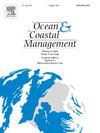陆海协调背景下多可持续发展目标协同对可持续发展目标14的相互作用机制:多尺度分析
IF 5.4
2区 环境科学与生态学
Q1 OCEANOGRAPHY
引用次数: 0
摘要
可持续发展目标14旨在实现海洋的可持续发展。然而,多个可持续发展目标在不同空间尺度上相互作用影响可持续发展目标14的机制尚不清楚。本研究首先确定了与可持续发展目标14关系最密切的5个关键可持续发展目标(可持续发展目标6、8、9、11、12),然后利用偏最小二乘结构方程模型(PLS-SEM)分析了中国沿海地区可持续发展目标协同效应对可持续发展目标14的局部影响。采用陆海权重矩阵的空间计量经济模型进一步量化了内陆可持续发展目标协同效应对沿海可持续发展目标14绩效的跨境影响。研究发现,在沿海地区,经济增长(SDG 8)和可持续消费与生产(SDG 12)对SDG 14的直接影响分别为0.55和0.422。工业化和基础设施(SDG 9)和可持续城市和社区(SDG 11)则具有抑制作用,其直接影响值分别为- 0.567和- 0.554。值得注意的是,所有间接影响都不显著,这表明沿海地区的可持续发展目标协同效应对可持续发展目标14没有影响。这是由于相互作用途径的复杂性,导致影响相互抵消。在陆地与沿海地区跨境互动层面,内陆可持续发展目标协同效应对沿海地区可持续发展目标14产生正向溢出效应,内陆非相邻省份的效应强于相邻省份。这些发现强调需要采取政策干预措施,加强可持续发展目标之间的协调,以避免抵消效应;跨区域协调是必不可少的,特别是为了鼓励不相邻的内陆捐款。总体而言,该研究为中国推进可持续发展目标14和寻求陆海协调提供了参考见解。本文章由计算机程序翻译,如有差异,请以英文原文为准。
The interaction mechanism of multi-SDG synergy on SDG 14 in the context of land-sea coordination: A multi-scale analysis
SDG 14 aims to achieve the sustainable development of oceans and seas. However, the mechanisms through which multiple SDGs interact to influence SDG 14 across different spatial scales remain unclear. This study first identifies the five key SDGs (SDGs 6, 8, 9, 11, 12) most closely related to SDG 14, then it employs partial least squares structural equation modelling (PLS-SEM) to analyze the local impact of SDG synergies on SDG 14 in Chinese coastal areas. A spatial econometric model with a land-sea weight matrix further quantifies the cross-border effects of inland SDGs synergies on the performance of coastal SDG 14. We found that in terms of local interaction in coastal areas, economic growth (SDG 8) and sustainable consumption and production (SDG 12) positively impact SDG 14 in coastal areas, with direct effects of 0.55 and 0.422, respectively. In contrast, industrialization and infrastructure (SDG 9) and sustainable cities and communities (SDG 11) exert suppressive effects, with direct impacts of −0.567 and −0.554. It is worth noting that all indirect effects are insignificant, suggesting that SDG synergies in coastal areas have no impact on SDG 14. This is due to the complexity of the interaction pathways, which causes the effects to cancel each other out. At the level of cross-border interaction between land and coastal area, inland SDG synergies generate positive spillover effects on coastal SDG 14, with stronger effects from non-adjacent inland provinces than from adjacent ones. These findings underscore the need for policy interventions to strengthen coordination among the Sustainable Development Goals (SDGs) to avoid offsetting effects; Cross-regional coordination is essential, especially to encourage non-adjacent inland contributions. Overall, the study provides reference insights for China to promote its SDG 14 and the search for land-sea coordination.
求助全文
通过发布文献求助,成功后即可免费获取论文全文。
去求助
来源期刊

Ocean & Coastal Management
环境科学-海洋学
CiteScore
8.50
自引率
15.20%
发文量
321
审稿时长
60 days
期刊介绍:
Ocean & Coastal Management is the leading international journal dedicated to the study of all aspects of ocean and coastal management from the global to local levels.
We publish rigorously peer-reviewed manuscripts from all disciplines, and inter-/trans-disciplinary and co-designed research, but all submissions must make clear the relevance to management and/or governance issues relevant to the sustainable development and conservation of oceans and coasts.
Comparative studies (from sub-national to trans-national cases, and other management / policy arenas) are encouraged, as are studies that critically assess current management practices and governance approaches. Submissions involving robust analysis, development of theory, and improvement of management practice are especially welcome.
 求助内容:
求助内容: 应助结果提醒方式:
应助结果提醒方式:


